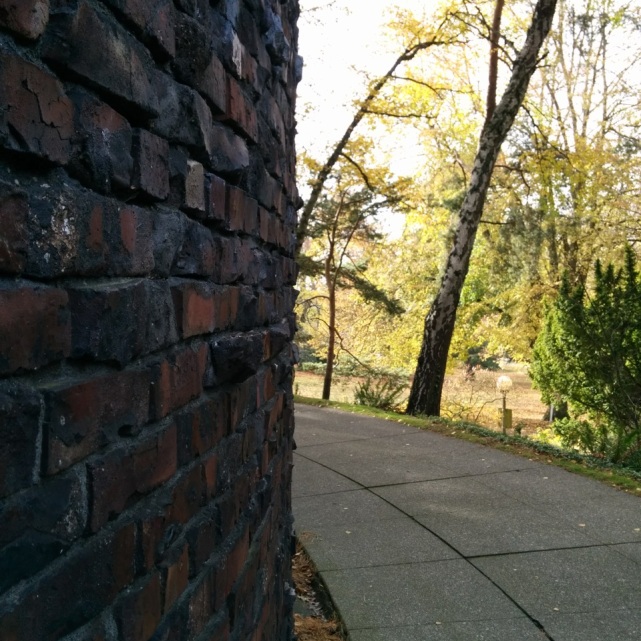The boot animation.
I have been taking the Nexus 5 with me for the last couple of days, and here are my impression so far.
1. Build
Unlike the Nexus 4, the black Nexus 5 has a soft touch plastic on its back. This makes it feel less slippery than the Nexus 4 (the Nexus 4 can slide down from a desk on its own, that’s how slippery it is). People are saying the white one is more “plasticky” though. I like the soft touch back. It makes the phone feel more durable than the glass Nexus 4. Alas, the material that Google uses actually attracts dust fairly easily. The Nexus 4 does still feel a bit more premium thanks to the glass back. It has the iPhone 4 feel, while the Nexus 5 feels more like a Lumia, well built but not as premium.
Swiping my finger on the Nexus 4 is a joy thanks to its curved glass at the edge. Alas, the Nexus 5 has a sharper edge, making it feel less “luxurious” when swiping my finger over the edge. The buttons have been changed too. It feels more solid than the Nexus 4, but the sharp edges on the buttons, especially the power button, can be jarring on the fingers compared to the Nexus 4.
The Nexus 5 is as big as the HTC One, but it has a bigger screen (4.95″ vs 4.7″ on the HTC One). It is much lighter, even lighter than the Nexus 4. The soft touch back actually makes it feel smaller than the HTC One. It feels nice on the hand, while sometimes I feel the HTC One is too big.
One huge annoyance for me? The SIM slot. The Nexus 4 uses a non-standard pin hole for its SIM slot, requiring a tinier pin to open (vs the bigger hole on the iPhone and HTC One). Well, the Nexus 5 uses yet another different pin hole. The pin included with the Nexus 4 does not work anymore, as the Nexus 5 requires a longer pin. WTF LG? WTF Google? Seriously?
2. Screen
The Nexus 4 has a pretty conservative auto-brightness. The after effect is that people has poor impression of the screen. Coupled with the prevalence of AMOLED screens, the Nexus 4’s screen looks washed out. Google for some reason is aggressively pushing the brightness on the Nexus 5 to combat this first impression. However, we know that more brightness equals less battery life. The Nexus 5 screen is great. It’s sharp thanks to the 1080p resolution. I do still think the HTC One to be better, mainly due to more saturation in color that make images pop.
3. KitKat
The Nexus 5 is running the latest Android, version 4.4, dubbed KitKat. Main thing I notice is that the wallpaper takes over the whole screen, meaning that there is no more black bars on the status and navigation bars. The icons on the status bar are now white in color. In the past, the wifi and signal bar icon are grey in color when connected wirelessly, and blue when the phone is connected to Google services. A small indicator would also pop up whenever there are data transmissions occurring. Those are all gone in KitKat. The icons will be just white, and there are no indicators of data transmissions. You have to go to the control center (2 finger swipe down) to see those indicators (the wireless icons will be orange if the phone is connected wirelessly but not to Google, and there are small triangles indicating data transmissions). This makes it less intuitive to troubleshoot connectivity problems.
The home screens have been rearranged. The main home screen is not the “middle” screen anymore. It is the first screen instead. Swiping to the right will actually reveal Google Now screen on the left. It is similar to iOS 6 when swiping to the right will reveal spotlight search. By default, there are only two home screens. I don’t see a direct way to add more home screens, other than dragging a widget passing the last screen on the right, then KitKat will create a new home screen.
Google Now will now respond once you unlock your phone, meaning that you don’t have to have Google Now running. Unlock the phone, and you can say “Ok Google” right away. It is similar to Motorola’s touchless control, but with the Moto X, it can respond even when it’s locked. So the implementation on the Nexus 5 feels half-baked. Even Siri can be initiated right from the lock screen without unlocking the iPhone.
The lock screen has been redesigned too. In 4.2, there is no indication that you can swipe the lock screen to the left to run the camera app, other than a brief flash of outlines on the sides of the screen when you wake up the phone. In KitKat, Google followed iOS, by providing a camera icon on the lower right corner. Following the bottom of the screen, there is an arrow pointing up in the middle, This replaces the dotted circle on 4.2 to access Google Now. Thing is, at first that up arrow makes me think that I can swipe the lock screen up to start the camera, just like the iPhone. Well, to start the camera, you have to actually swipe to the left instead. I can see new users being confused at first.
Another change in KitKat UI is the icons. They are overly large. The App drawer now only contains 4 x 5 grid instead of 5 x 5 on the Nexus 4. The icon size is so large that it feels downright silly. This also makes folders in the home screen to cover up more space that it did before. Aesthetically annoying as it makes the screen feels cramped.
The regular messaging app is gone. Everything is handled under Hangouts. Like it or not, Google wants you to use Hangouts and join Google Plus. This consolidation of messaging apps is welcomed, but Google created another confusion. This is not exclusive to KitKat, but with the new push of Google Plus, now there are two apps to access your photos. The classic Gallery app, and the new Photos app that integrates the camera roll with Google Plus. Confusing? Yeah. I can see the classic Gallery app going away, although I really like it.
In terms of responsiveness, the Nexus 5 is fast. It is so fast that it actually make the Nexus 4 feels slow. Side by side, when opening apps and menus, there is a noticeable delay on the Nexus 4 compared to the Nexus 5. Now the Nexus 4 is by no means slow/laggy, but there is this noticeable hesitations on every screen transitions compared to the Nexus 5. Not sure if this is due to KitKat or just because of the beefier hardware of the Nexus 5, but hopefully KitKat can bring some smoothness to all Android devices.
4. Battery Life
Non-scientifically, it’s a meh. I took the Nexus 5 along with my iPhone 5 for a stroll. Both have everything on (wifi, cellular radio, GPS, etc), and same email accounts configured. I used both to take similar number of pictures. After a few hours, both are showing around 75% of battery life left. Thing is, I had the iPhone also running a location tracking app, while the Nexus 5 did not have this app running. Considering how the iPhone 5 battery is a lot smaller, this tells me that the Nexus 5 and/or Android is less efficient than the iPhone/iOS. Seems like Android does not behave well, especially when cellular signal is weak. I notice this also on the HTC One as the battery drains pretty quick when it is in low signal area. Heavy users might want to have an external battery pack handy just in case.
5. Camera
I did a comparison of the Nexus 5 camera with some other devices on the previous post. Here are some more pictures to enjoy. 🙂
The HTC One is showing a weakness here. The Nexus 5 fares okay, while the iPhone 5 continues to provide the best balance. Throughout this post, you will see inconsistent white balance from all devices. It is also interesting to see the different FOV of each devices (the HTC One having the widest FOV).
Getting this image was an interesting experience. I actually had a hard time making the leaf in focus with the iPhone 5. I had to go very close before it focused properly. I’m guessing the iPhone has a minimum range where it initiates its macro mode focusing. The HTC One took the picture without much fuss. The Nexus 5 had trouble in its metering, resulting in a dark image although the leaf was in focus properly.
Wow, white balance all over the place. 😀 The HTC One doesn’t look good here. It seems that it had trouble in determining the white balance and overblowing the highlights. The Nexus 5 did an okay job though. I kinda like the warmer tones in this context. The Nexus 4 trailed behind, but you can probably do some post processing to make it look decent. The iPhone, again, gave the most balanced picture.
This was a tough picture to take. I wanted to focus on the lower right fruit. After numerous tries, I just couldn’t do it with the Nexus 5 and the stock camera app. Same thing with the Nexus 4, it was impossible. The iPhone also had a difficult time, but I finally got a focus, albeit resulting a dark picture due to the phone trying to compensate for the sky. The HTC One? Well, at first, I had trouble with it too. But a simple flip to macro mode, bam! It took the picture like a champ. 🙂
On the Nexus 5 and Nexus 4, I tried using a camera app called Camera360. This app has multiple options, including macro mode. Although it was still a difficult process with multiple tries, I finally got something. Not great, but it’s something. The HTC One definitely took the cake this round.
These were another difficult shot, with dark and bright areas. The Nexus 5 did okay. It dropped down its shutter speed to 1/9 to help with light while keeping the ISO low. Problem is, it is susceptible to blurring due to shake (despite having optical image stabilization). Not bad, but not as sharp as the iPhone 5. The Nexus 4 had to resort to high ISO, giving noisy picture. The HTC One suffered overblown highlights, its achilles heel.
Throughout this experiment, I was really annoyed with Android stock camera app. The camera start-up on the Nexus 5 is slow. When switching from portrait to landscape or vice versa, there is a significant lag. Yes, lag, on a quad-core snapdragon 800 phone. There is really no excuse there. The focusing system is slow, and it wanted to keep focusing at the center. I observed it changing the focus to the center even while it was taking a picture, which can sometimes create out-of-focus picture. It’s ridiculous. The camera itself is capable on producing decent images. Google needs to really work on the software side.
The HTC One continues to be a joy to use. Startup is fast, focusing is fast, and it is the only one having a specific macro mode. Sometimes relying on auto everything is not necessarily the best way (e.g. the iPhone having issues with the leaf). Even better, its gorgeous screen makes you enjoy the pictures right away. Its weaknesses at this point are well known though, especially the overblown highlights.
In the end, the iPhone takes the best balanced pictures in most situations. Apple just know their stuff. Start up is fast, focusing is fast, and other than some issues in specific instances, it just works. However, during this experiment, I wish it had a larger screen. 😉
If you are going to take a lot of pictures, get the iPhone. You have to have a lot of patience with the Nexus 5.
6. Conclusion
Well, there you go. My quick impression of the Nexus 5. It is Google’s latest, and the only way to enjoy KitKat out of the box right now. It feels great on the hand, but I would still invest in a case. It has top notch spec, yet Google is still skimping on certain things, like the stock camera app. Despite all the drawbacks, one has to remember that this is a $350-$400 phone. It’s cheaper than even the iPhone 4S! 😀 It’s an excellent phone for the money. Hopefully my impression can help your decision, or at least make you feel better about your purchase. 😀



























One response to “More Nexus 5 Impression and Camera Comparison #nexus5”